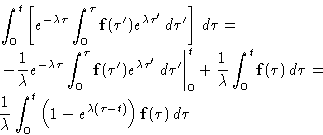Next: Diffusion Approach. Focker-Planck Equation Up: Brownian Motion and Focker-Planck Previous: Brownian Motion and Focker-Planck
![]()
![]()
![]()
Next: Diffusion Approach. Focker-Planck Equation
Up: Brownian Motion and Focker-Planck
Previous: Brownian Motion and Focker-Planck
We have one particle surrounded by small molecules. At t=0 it had
![]() . We want to calculate its position at the time t.
. We want to calculate its position at the time t.
Assumptions:
| |
(1) |
| |
(2) |
| |
(3) |
This is called Langevin equation. Langevin equation describes
system with white noise acting on ![]() .
.
| |
(4) |
Solution of Langevin equation for ![]() is
is
| |
(5) |
Solution for ![]() is
is
![]()
![]()

We obtained:
![]()
![]()
![]()
![\begin{displaymath}
\begin{split}
&\frac{1}{\lambda^2}\int_0^t d\tau \int_0^t d...
... \frac{1}{2\lambda}e^{-2\lambda t}-\frac32\right]
\end{split} \end{displaymath}](img22.gif)
![\begin{displaymath}
\begin{split}
&\left\langle \mathbf{r}^2(t)\right\rangle =...
...
\frac{1}{2\lambda}e^{-2\lambda t}-\frac32\right]
\end{split}\end{displaymath}](img23.gif) |
(6) |
![]()
At large t
![]()
The large time limit could be obtained from the Wiener equation
| |
(7) |
![]()
White noise in Wiener equation is the consequence of the averaging out a fast process--in our case, velocity relaxation!
© 1997 Boris Veytsman and Michael Kotelyanskii